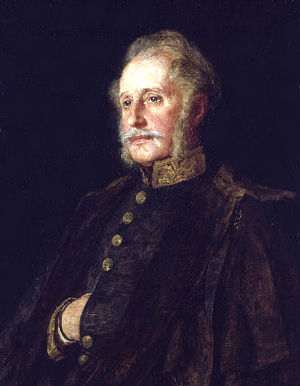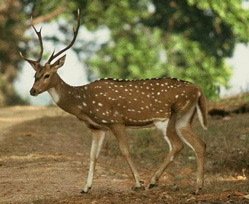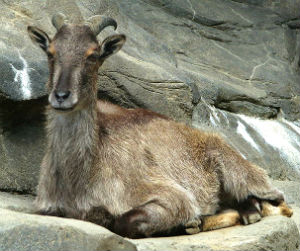Axis Deer × Himalayan Tahr
Axis axis × Hemitragus jemlahicus
EUGENE M. MCCARTHY, PHD GENETICS
Things you don't expect happen more often than things you do.
—Plautus, Mostellaria
|

Brian Houghton Hodgson
(1801-1894)

Axis deer
Axis axis

Himalayan Tahr (
Hemitragus jemlahicus)
Image: Kevin Payravi, Wikimedia Commons
Brian Houghton Hodgson (1801-1894) was a naturalist, ethnologist and British civil servant who worked in India and Nepal. He was the first describer of numerous Himalayan birds and mammals, and several birds were named for him by others.
Hodgson was the namer of the Himalayan Tahr's genus Hemitragus. He described (Hodgson 1847, p. 699) the Himalayan Tahr as
A very remarkable type tending to connect the keeled, compressed hollow-horned and odorous goats with the deer family which want these marks, but possess the mufle and 4 teats of the Hemitrages, marks which the true Goats (and Sheep) are void of.
On the next page of the same article, he states further that “in February 1842, a male Jháral [i.e., a Himalayan Tahr] in possession of the Court of Nepaul [i.e., Nepal] had intercourse with a female Axis,
which in July produced a young hybrid of mixed appearance, but more like the mother than the father, and which lived and grew up a fine animal. I saw it last in October 1843. I note the circumstance as a strong corroboration of that affinity of the Hemitrages to the Deer, not Bovines as Mr. Ogilby supposed, which is indicated by the 4 teats and moist muzzle of the former, notwithstanding that the Hemitrages in all other parts of their structure, as well as in their rank odour and in their manners are such perfect goats. From the true goats, however, they differ, besides the grand points noted, by the total absence of beard and of feet pores. Nor could I ever get any progeny from the goats by the Jháral, though my male of the latter species had commerce with Goats of several breeds, repeatedly during the 6 years he lived with me, quite tame and going abroad with the sheep and goats.
The axis deer and Himalayan tahr apparently have an altitudinal contact zone at an elevation of about 1300 meters. According to the IUCN,
the northern boundary [of the range of Axis axis] runs along the bhabar-terai belt of the foothills of the Himalayas from Uttar Pradesh and Uttaranchal through Nepal, northern West Bengal and Sikkim to western Assam and the forested valleys of Bhutan below 1,100.
As for H. jemlahicus, the IUCN states that it ranges as low as 1,500 meters in Nepal. So the upper bound of the latter comes within 400 meters of the lower bound of the latter, and occasional natural contact between the two therefore seems likely.
Other unusual cervid crosses: Red deer × Cow, Roe Deer × Sheep, Reindeer × Cow, Moose × Cow, Goat × Deer, Deer × Horse.
A related cross >>
Table of contents >>
Bibliography >>
Internet citations >>
Biology Dictionary >>
By the same author: Handbook of Avian Hybrids of the World, Oxford University Press (2006).
Axis Deer × Himalayan Tahr - © Macroevolution.net
 Brian Houghton Hodgson
Brian Houghton Hodgson Axis deer
Axis deer Himalayan Tahr (Hemitragus jemlahicus)
Image: Kevin Payravi, Wikimedia Commons
Himalayan Tahr (Hemitragus jemlahicus)
Image: Kevin Payravi, Wikimedia Commons